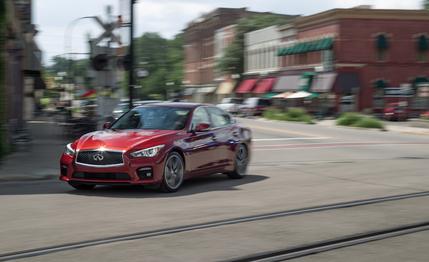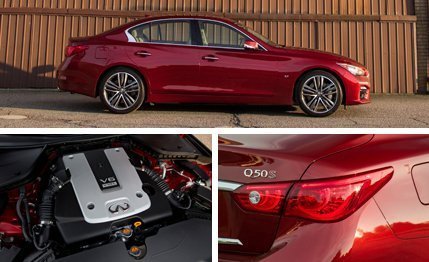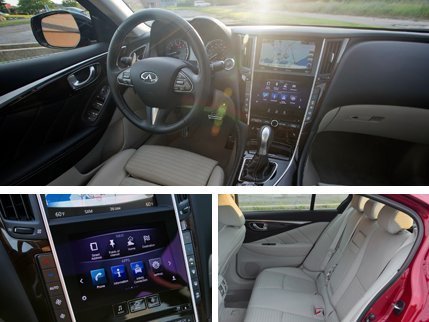 Instrumented Test
Instrumented Test
Infiniti’s starter car, its G sedan, has been a scrappy back-road stalwart and a convincing BMW 3-series alternative since the third-gen model adopted rear-drive in 2003. But as the company attempts to reinvent itself by moving its base of operations to Hong Kong, writing sponsorship checks with many zeros to Formula 1, and curiously renaming its model range, its core sports sedan has also evolved. Where once romped a lively four-door now goes a rolling flea circus of driver-reduction technology that tries but ultimately fails to simulate all that was good about its predecessor.
Unlike the latest F30 BMW, which grew substantially over the E90 3-series it replaced, the new Q50 sizes up about the same as the previous G37, save for an additional two inches in width. But those two inches are significant, as is the car’s more relaxed demeanor. In our road test of the top-shelf, 360-hp Q50S hybrid [“Cable Car,” October 2013], we likened the styling and deportment to that of the larger M sedan (now called the Q70) and lamented its diluted sense of driver involvement.
Nonhybrid Q50s carry over a port-injected, 3.7-liter V-6 making 328 horsepower and 269 pound-feet of torque. Backed exclusively by a quick-shifting seven-speed automatic, the V-6 flung our 3784-pound S model to 60 mph in 5.2 seconds and through the quarter in 13.9 at 102 mph—a tenth of a second behind the heavier, rear-drive hybrid on both counts. The Q50’s track stats are wholly competitive with those of its peers, as well as the previous G37S’s. But the helm bestows less confidence than before, which makes probing the car’s limits more like guesswork and less satisfying than it should be.
 The Q50Ss V-6, boasting 328 horses and 269 pound-feet of torque, hustles the car to 60 mph in 5.2 seconds. But it doesnt sound happy producing those numbers.
The Q50Ss V-6, boasting 328 horses and 269 pound-feet of torque, hustles the car to 60 mph in 5.2 seconds. But it doesnt sound happy producing those numbers.
Bend the Q50 into a corner and it’s not the playful G that we most recently said had “Porsche-like steering feel.” Despite the S model’s aggressive bodywork, 19-inch wheels with Dunlop summer tires, larger brakes, and a firmer suspension tune, our test car was stingy on driving rewards. Toggling the Drive Mode Selector on the console adjusts the steering, throttle, gearbox, and suspension settings through several modes (snow, eco, standard, sport, and personal), but a sense of understeer and disconnectedness is ever present.
The Q50’s electronic Direct Adaptive Steering is largely to blame. The first production steer-by-wire system, it lacks feedback and natural-feeling resistance proportional to cornering loads. Also, the steering response can be almost too quick for the chassis setup. The robo-rudder is standard on hybrids and optional on other models as part of the $3100 Deluxe Touring package, which bundles amenities such as memory seating, fold-down rear seats, and Infiniti’s Around View Monitor. Thus far we haven’t driven a Q50 without the system, but we can’t wait to.
Now to the engine compartment: Whereas a BMW 335i’s turbo six delivers its full 300 pound-feet at 1200 rpm and pulls linearly to the redline, you have to wait for the Infiniti’s peak twist until 5200 rpm. Forward haste requires exaggerated throttle inputs, which get tiresome as the VQ V-6 groans and thrashes at high revs. Without the hybrid’s electric assist, this car’s observed fuel economy suffered, dropping from 29 mpg to 21. Opting for four-wheel drive ($1800) results in a 1-mpg hit to the nonhybrid’s combined EPA rating of 23.
 Infinitis parent, Nissan, promises a fully autonomous vehicle by 2020. The Q50s steering betrays that ambition.
Infinitis parent, Nissan, promises a fully autonomous vehicle by 2020. The Q50s steering betrays that ambition.
Even in light of refinements such as a much-improved ride versus previous Infinitis, which often had the damping quality of bedrock, we find the Q50 to be more about luxury and electronic thingamajiggery than the old G ever was. The business-like cabin is comfortable, airy, and awash with driver aids and high-res readouts, but the materials are a bit uninspiring. Selecting the $3200 Technology package brings acronym overload. Infiniti’s latest safety systems help drivers avoid running into things, possibly while setting high scores on Fruit Ninja. Drivers who just pay attention can probably live without its multitude of beeps and warnings and save the money, especially considering the S model’s starting point has increased slightly to $44,105—about the same as a rear-drive BMW 335i sedan. Adding Infiniti’s latest navigation system ($1400) pushed our car’s as-tested sticker price to a hardly thrifty $51,805.
Despite input from three-time Formula 1 champ Sebastian Vettel, the Q50’s weakened fun factor seems at odds with Infiniti’s decision to name Vettel “director of performance” for its road cars. Whatever the brand’s grand ambitions, it has produced a Q car that is softer and more luxurious overall by dispensing with the G37’s most endearing quality: its exuberance. Now it’s just another pretty, comfortable, and tech-laden 50-grand car.